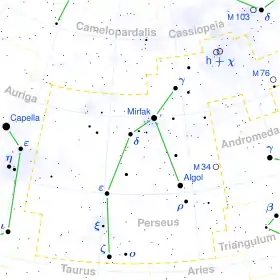X Persei
X Persei is a high-mass X-ray binary system located in the constellation Perseus, approximately 950 parsecs away. It is catalogued as 4U 0352+309 in the final Uhuru catalog of X-ray objects.
| Observation data Epoch J2000.0 Equinox J2000.0 | |
|---|---|
| Constellation | Perseus |
| Right ascension | 03h 55m 23.0779s[1] |
| Declination | +31° 02′ 45.046″[1] |
| Apparent magnitude (V) | 6.778[2] (6.03 - 7.00[3]) |
| Characteristics | |
| Spectral type | O9.5IIIe-B0Ve[4] |
| U−B color index | −0.790[2] |
| B−V color index | +0.137[2] |
| Variable type | γ Cas + X-ray pulsar[3] |
| Astrometry | |
| Radial velocity (Rv) | −50.00[5] km/s |
| Proper motion (μ) | RA: −1.397[1] mas/yr Dec.: −2/254[1] mas/yr |
| Parallax (π) | 1.2342 ± 0.0562[1] mas |
| Distance | 2,600 ± 100 ly (810 ± 40 pc) |
| Absolute magnitude (MV) | −3.47[2] |
| Orbit[6] | |
| Period (P) | 250.3 days |
| Semi-major axis (a) | 2.2 AU |
| Eccentricity (e) | 0.111 |
| Inclination (i) | 23 - 30° |
| Details | |
| Mass | 15.5[7] M☉ |
| Radius | 6.5[7] R☉ |
| Luminosity | 29,000[2] L☉ |
| Surface gravity (log g) | 4.0[2] cgs |
| Temperature | 29,500[7] K |
| Rotational velocity (v sin i) | 215[2] km/s |
| Age | 5[2] Myr |
| Other designations | |
| Database references | |
| SIMBAD | data |
The conventional star component of X Persei has been classified either as an O-type giant or a B-type main sequence star. It is a Be star, rotating rapidly, and at times surrounded by a disk of expelled material. This qualifies it as a Gamma Cassiopeiae variable, and the visual range is magnitude 6 - 7. In 1989 and 1990, the spectrum of X Persei changed from a Be star to a normal B class star while it faded significantly. This appears to have been caused by the loss of the accretion disk. The disk has since reformed and shows strong emission lines.[8]
The system also contains a neutron star which is a pulsar with an unusually long period of 837 seconds.[6] The pulsar has shown period changes that are associated with mass transfer from the more massive primary star. Between 1973 and 1979 it was seen to increase its rate of spin, associated with a strong x-ray flare and presumed strong mass transfer. Since then the spin has been slowing despite small x-ray flares.[8]
The combination of a neutron star and OB emission line star places X Persei in the Be/X-ray binary class of stars.[8]
There is a faint optical companion separated by 22.5" which the Catalog of Components of Double and Multiple Stars refers to as X Persei B.[9] It is a background red giant[10] and a candidate long period variable with the variable star designation V397 Persei.[3]
References
- Brown, A. G. A.; et al. (Gaia collaboration) (August 2018). "Gaia Data Release 2: Summary of the contents and survey properties". Astronomy & Astrophysics. 616. A1. arXiv:1804.09365. Bibcode:2018A&A...616A...1G. doi:10.1051/0004-6361/201833051. Gaia DR2 record for this source at VizieR.
- Lyubimkov, L. S.; Rostopchin, S. I.; Roche, P.; Tarasov, A. E. (1997). "Fundamental parameters, helium abundance and distance of X Persei". Monthly Notices of the Royal Astronomical Society. 286 (3): 549. Bibcode:1997MNRAS.286..549L. doi:10.1093/mnras/286.3.549.
- Samus, N. N.; Durlevich, O. V.; et al. (2009). "VizieR Online Data Catalog: General Catalogue of Variable Stars (Samus+ 2007-2013)". VizieR On-line Data Catalog: B/gcvs. Originally Published in: 2009yCat....102025S. 1. Bibcode:2009yCat....102025S.
- Valencic, Lynne A.; Smith, Randall K. (2013). "Interstellar Abundances toward X Per, Revisited". The Astrophysical Journal. 770 (1): 22. Bibcode:2013ApJ...770...22V. doi:10.1088/0004-637X/770/1/22. hdl:2060/20120015666.
- Kharchenko, N. V.; Scholz, R.-D.; Piskunov, A. E.; Röser, S.; Schilbach, E. (2007). "Astrophysical supplements to the ASCC-2.5: Ia. Radial velocities of ˜55000 stars and mean radial velocities of 516 Galactic open clusters and associations". Astronomische Nachrichten. 328 (9): 889. arXiv:0705.0878. Bibcode:2007AN....328..889K. doi:10.1002/asna.200710776. S2CID 119323941.
- Delgado‐Marti, H.; Levine, A. M.; Pfahl, E.; Rappaport, S. A. (2001). "The Orbit of X Persei and Its Neutron Star Companion". The Astrophysical Journal. 546 (1): 455–468. arXiv:astro-ph/0004258. Bibcode:2001ApJ...546..455D. doi:10.1086/318236. S2CID 118872096.
- Grundstrom, E. D.; Boyajian, T. S.; Finch, C.; Gies, D. R.; Huang, W.; McSwain, M. V.; O'Brien, D. P.; Riddle, R. L.; Trippe, M. L.; Williams, S. J.; Wingert, D. W.; Zaballa, R. A. (2007). "Joint Hα and X-Ray Observations of Massive X-Ray Binaries. III. The Be X-Ray Binaries HDE 245770 = A0535+26 and X Persei". The Astrophysical Journal. 660 (2): 1398–1408. arXiv:astro-ph/0702283. Bibcode:2007ApJ...660.1398G. doi:10.1086/514325. S2CID 7531501.
- Li, Hui; Yan, Jingzhi; Zhou, Jianeng; Liu, Qingzhong (2014). "Long-term Optical Observations of the Be/X-Ray Binary X Per". The Astronomical Journal. 148 (6): 113. arXiv:1408.3542. Bibcode:2014AJ....148..113L. doi:10.1088/0004-6256/148/6/113. S2CID 119282584.
- Dommanget, J.; Nys, O. (1994). "Catalogue des composantes d'etoiles doubles et multiples (CCDM) premiere edition - Catalogue of the components of double and multiple stars (CCDM) first edition". Com. De l'Observ. Royal de Belgique. 115: 1. Bibcode:1994CoORB.115....1D.
- Brown, A. G. A.; et al. (Gaia collaboration) (August 2018). "Gaia Data Release 2: Summary of the contents and survey properties". Astronomy & Astrophysics. 616. A1. arXiv:1804.09365. Bibcode:2018A&A...616A...1G. doi:10.1051/0004-6361/201833051. Gaia DR2 record for this source at VizieR.

